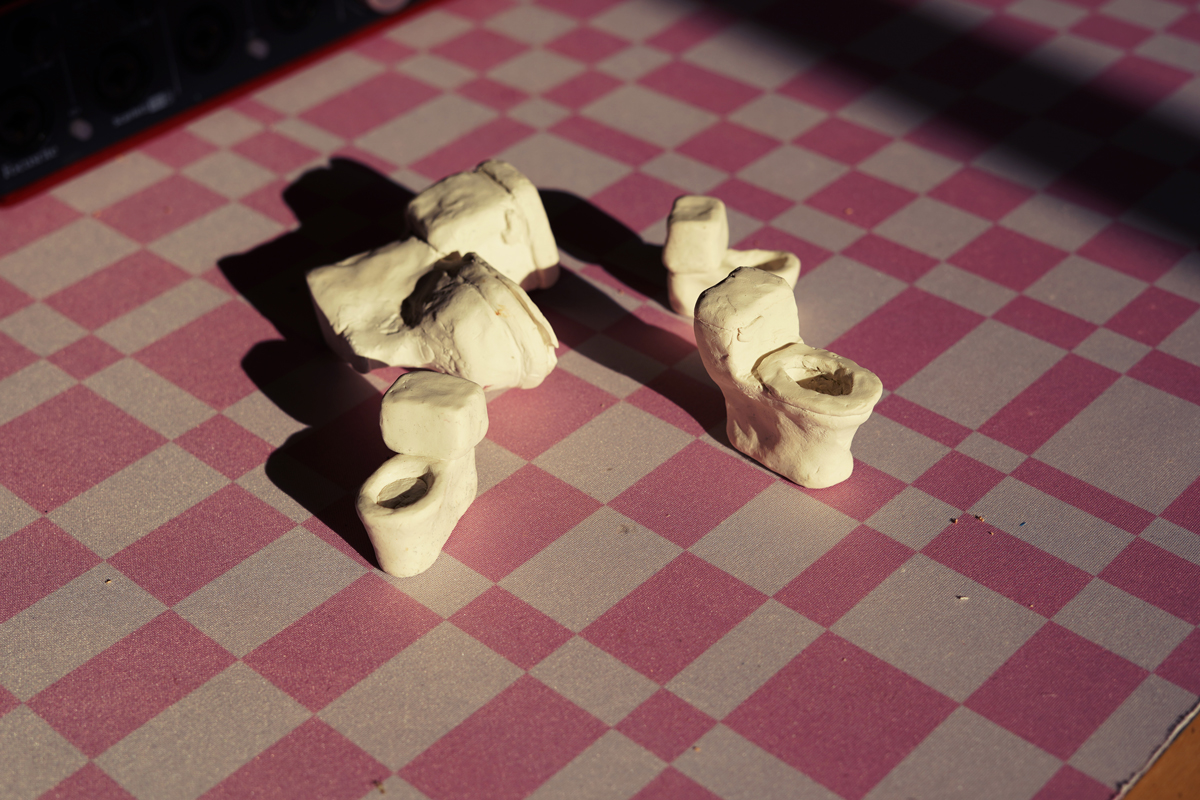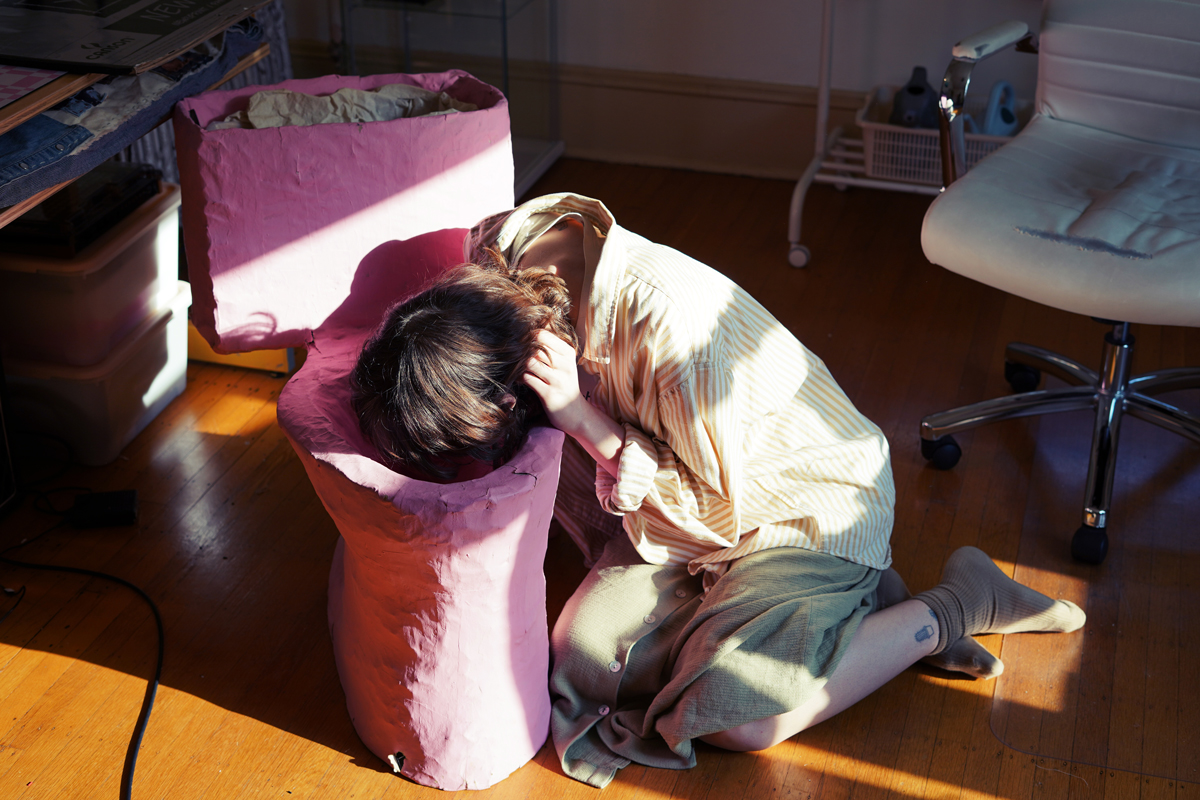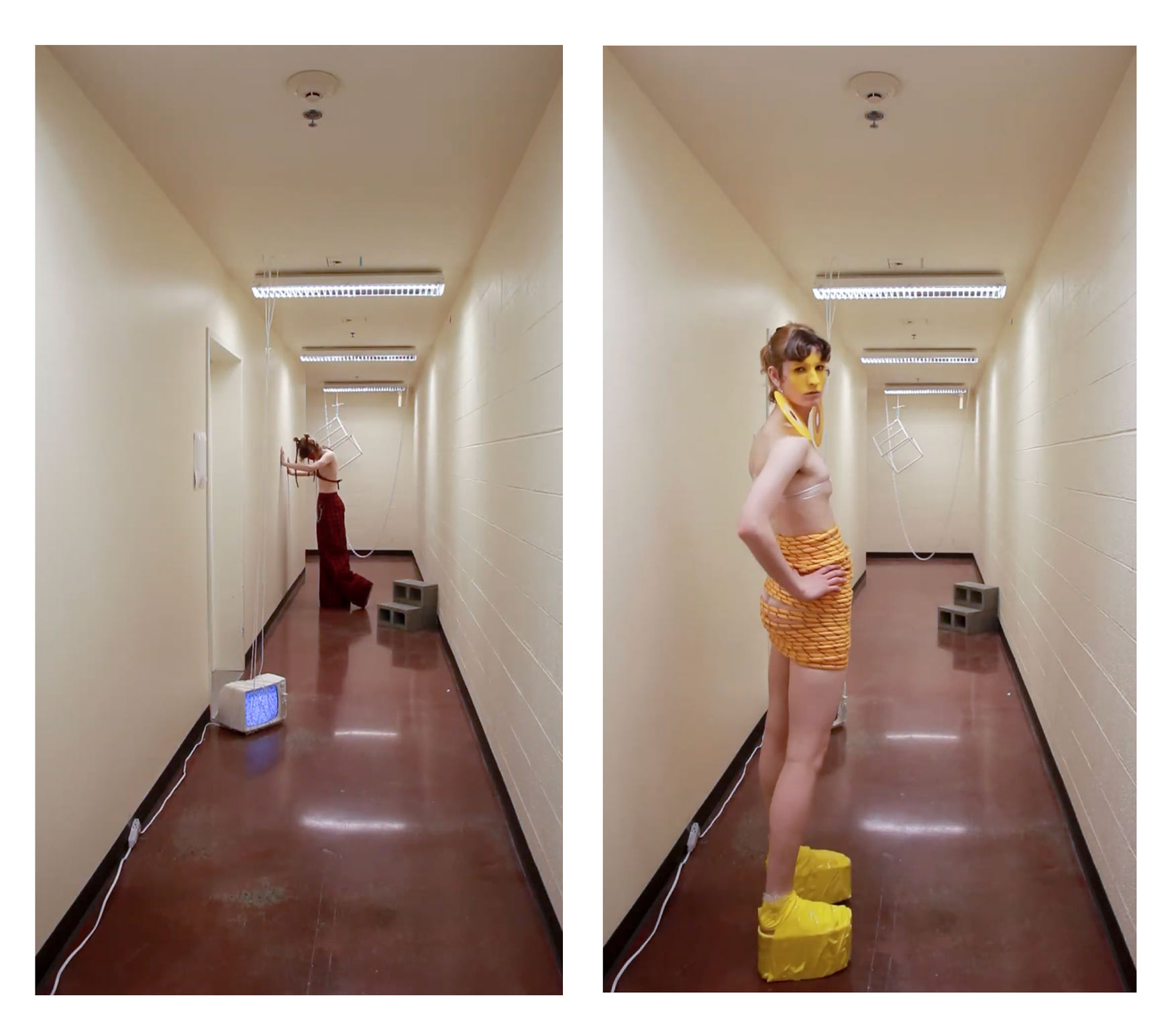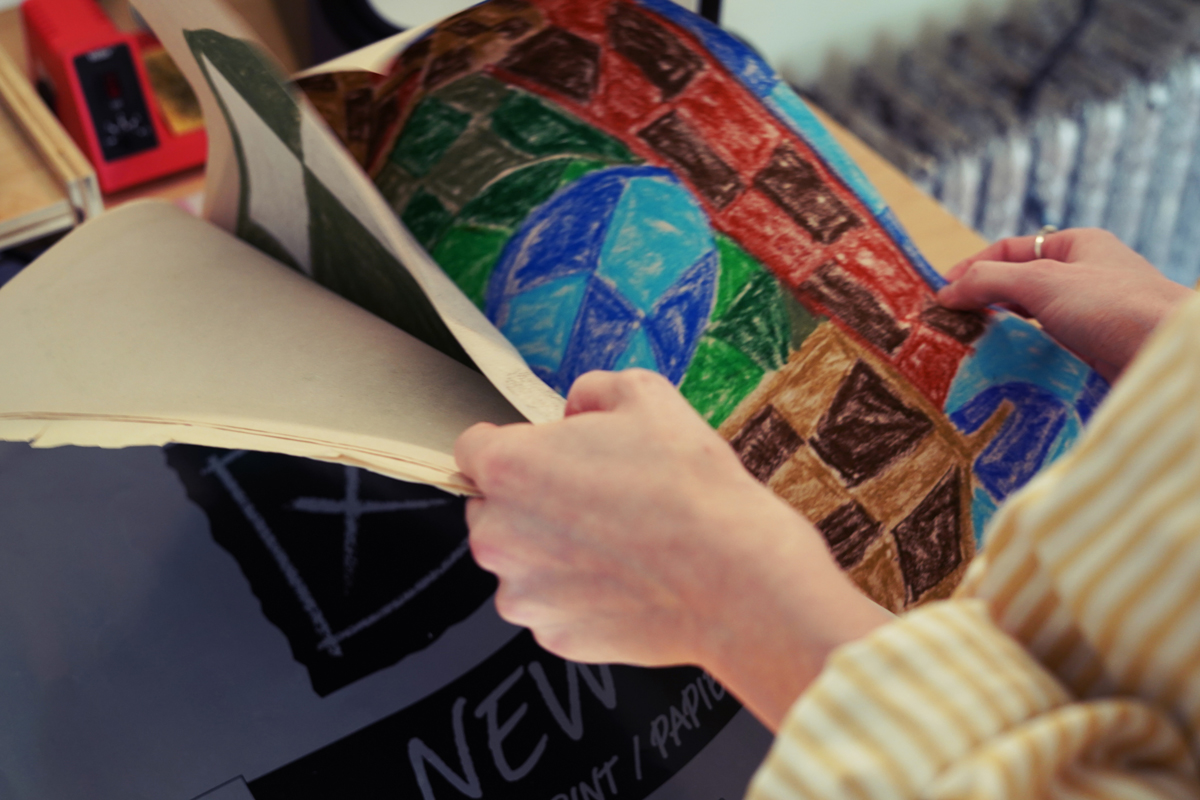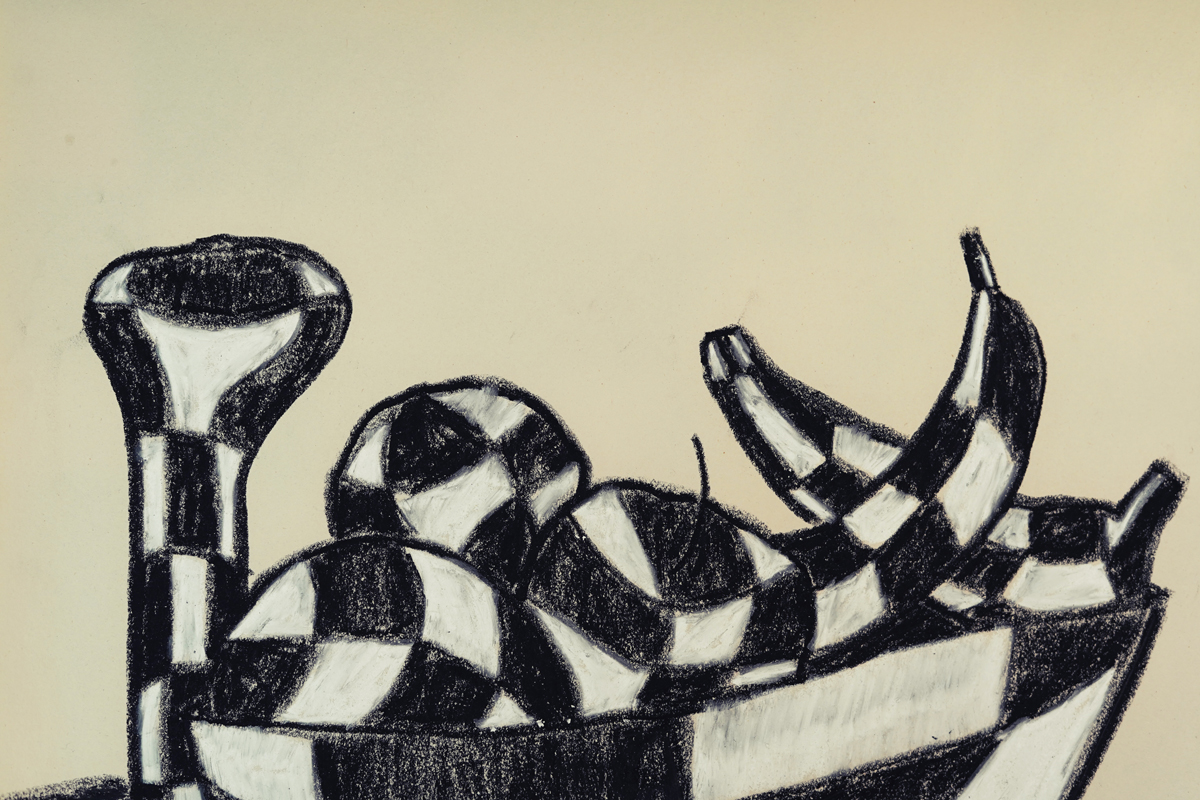This series highlights working artists currently on staff at the Frye Art Museum. The Frye has a wealth of talented Seattle-based artists working under its roof in many different capacities, each with their own dedicated arts practice outside of their work at the museum. Facilitated and written by Alexis L. Silva, Curatorial Assistant, this series is meant to highlight and celebrate these individuals, showcasing their amazing work and arts practices.

Photo: Alexis L. Silva
By Alexis L. Silva
Creating space for oneself is a lot more difficult than you’d think. There are so many factors that play a part in how we navigate both our personal and social spaces. While creating a personal environment seems like a no-brainer, it’s sometimes the context in which we attempt to create space that makes it difficult. These difficulties can lead to experimentation and self-discovery inscribing meaning into our everyday lives.
Lexi McCauley (She/They) is interested in this experimentation and uses space as a way to address lived experiences and social issues. From small performative gestures in a public men's bathroom, to filling her personal surroundings with movement, she uses space as a channel to understand the relationship between queerness and the physical world.
Lexi is the Frye’s beloved Graphic Designer, who implements visual design for a broad range of museum initiatives, from exhibitions to facilities, events, and marketing.
Tell us about your background. Have you always lived in Seattle? If not, what brought you here and why have you chosen to stay?
I moved to Seattle in 2016 to attend Seattle University for my undergraduate studies. I was drawn to the city for its reputation for a lively DIY music scene, rainy weather, progressive politics, and strong queer communities (the perfect foil to my home state of Arizona).
Tell us about your exploration of the relationship between queerness and physical space. What sort of questions do you ask yourself around these topics and how do you answer them through your work?
So much of my life I felt like I didn’t have the space to express my queerness, and my conceptual interest in space and identity emerged from that frustration. I grew up around Phoenix, which is a socially conservative place, broadly speaking. I was never really exposed to queerness as a kid, and when I was, it was often filtered through homophobia and transphobia. Early on, the only tangible representations of queerness I saw were in popular media depictions of LGBTQ people, which were often incomplete if not entirely incorrect or problematic. I went to a Catholic K-8 school and an all-boys Jesuit high school, both which basically ignored the existence of queerness or actively discouraged it.
Despite all that, when I was eleven or twelve, I started to feel that I might not be straight or cis. I didn’t feel safe coming out at the time, so I mostly stayed in the closet. The first time I really saw or interacted with other queer people wasn’t until I was 15 or 16. I went to my first house show around then and started playing and performing my own music. Those grungy living rooms and basements were the first places where I met other queer and trans people, and where I felt safe enough to wear a skirt, or paint my nails, or put on makeup, and kiss who I wanted to. I didn’t think much about it at the time, but those experiences were so formative. It’s where this idea about the importance of queer spaces started to materialize for me.
Moving to Seattle gave me more room to explore and express my queerness. This space and my community helped me feel safe enough to come out. Since then, the power of space and its relationship to identity became a key line of inquiry in my artistic practice.
The questions I ask myself:
-
What’s the relationship between space and the body—how do spaces and bodies derive meaning from each other?
-
What social constructions, expectations, and ideologies are present in our architecture and built environment?
-
How can I disrupt or transform the constructed meanings of a space?
My work is a somewhat experimental, abstract, and playful response to these questions. I use video, installation, and performance as tools to survey the body in space, to illustrate the connection between space and power, and to disrupt, transform or queer normative spaces. In practice, this all tends to look like a weird girl doing weird things in a men's restroom.
I was very fixated on this work titled Stamping in the Men’s Restroom, the minimal performative gesture is effective and almost hypnotic. Can you talk about these small performative exercises that appear in your work and how they speak to each other?
In college, I was introduced to the work of experimental video artists like Vito Acconci, Joan Jonas, Martha Rosler, and Bruce Nauman. Stamping in the Men's Restroom is a replication of Nauman's 1968 work, Stamping in the Studio. Like so many others that have seen this piece, I was hypnotized by Nauman's repetitive, rhythmic, and somewhat absurd exercise. But what seems on the surface to be absurd or meaningless, upon further investigation, expresses something surprisingly complex about space and its relationship to body and identity. Nauman’s work confronts the preconceived ideas that people have about the identity of the artist, the labor of creation, and the mythology of the studio. But what interested me the most was this idea that the body and the space create and inscribe meaning on each other. This was a useful reference for me at the start of my practice and so I decided to recreate his piece.
By changing the setting from the private space of an artist’s studio to the public space of a men's restroom, I intended to shift the central tension of Nauman’s performance. Rather than focus on the social expectations about artists and the studio, I wanted to probe at cis/het-normative ideas about gender and bathrooms, and the assumptions we make about the kinds of bodies that belong in them. The ideas we project onto spaces like bathrooms can seem so normal and harmless; they’re so deeply prevalent that they manifest literally in our architecture. Our world is so oversaturated with these ideas that they become invisible. But this is why ideas like these are so dangerous for trans people, because we exist in contradiction to those expectations.
I made this piece during a particularly contentious moment in the conversation around trans bodies and bathrooms here in the States, and part of this performance came from my own exasperation on the topic. Stomping in circles felt like an appropriate metaphor for my own feelings of helplessness and exhaustion, and this performance in the men’s bathroom was a way to point at the absurdity of it all. I wanted to emphasize the contradiction that trans bodies pose to normative expectations about gendered spaces. The performative exercises in this piece, and other pieces I’ve made, have become these kinds of rituals that point to the tension between space and body. It’s a simple but powerful way to convey something that’s felt so impossible for me to express in any other way. I hope that they insert new meaning into a space—to inscribe my queerness into them.
Checkers are a common pattern that appears a lot in your work. Can you talk about your interest in this motif and how you use it conceptually?
The checkers were originally inspired by bathroom floors. In 2020, I planned to exhibit a large-scale installation that would transform a gallery space into a full-scale bathroom with video projected throughout the space. I looked at bunch of photos of public bathrooms and I loved the ones with checkered floors, so I included checkers in the design. I wanted the space to feel somewhat unexpected and disorienting, so I played with the pattern—warping and distorting it until I came up with this amoeba-like checker blob that kind of escaped the floor and crawled up the wall. I had to cancel plans for the installation at the start of the pandemic—the only remnant I have left of that project is a full-scale papier mâché toilet that lives with me in my apartment—but I never stopped drawing checkers. I found that the pattern could be used to create these dazzling illusions of 3-D space. I started rendering more and more drawings with these loose chunky checkers that I intended to have a conceptual connection to the rest of my work.
How does fashion and clothing play a part in your practice?
Fashion has been important to me as a way to express my gender and queerness. In a somewhat more tangible way than the abstract notions of space, fashion has such an indescribable power to shape and express identity. In Queer Space I performed in these chaotic over-the-top handmade outfits. I wanted to wear something that drew a sharp contrast to the dullness of the performance space and matched a more exaggerated and vibrant form of my usual expression. I found that the clothes themselves affected the kinds of movements that I could perform and so I found that I was improvising movements that were directly inspired by the outfits I wore.
Tell us about your vision for the future of the Seattle arts community.
I want to see more art made by trans people and more spaces made for trans artists. I envision the reemergence of more DIY art and music spaces that disappeared over the pandemic. These are the kinds of spaces that made me who I am now.
Where can we find you? (Socials, website, upcoming events, etc.).
You might run into me somewhere on Capitol Hill—say hi if you do! Or you can find me at: leximccauley.com or on Instagram @_lexi.png_
